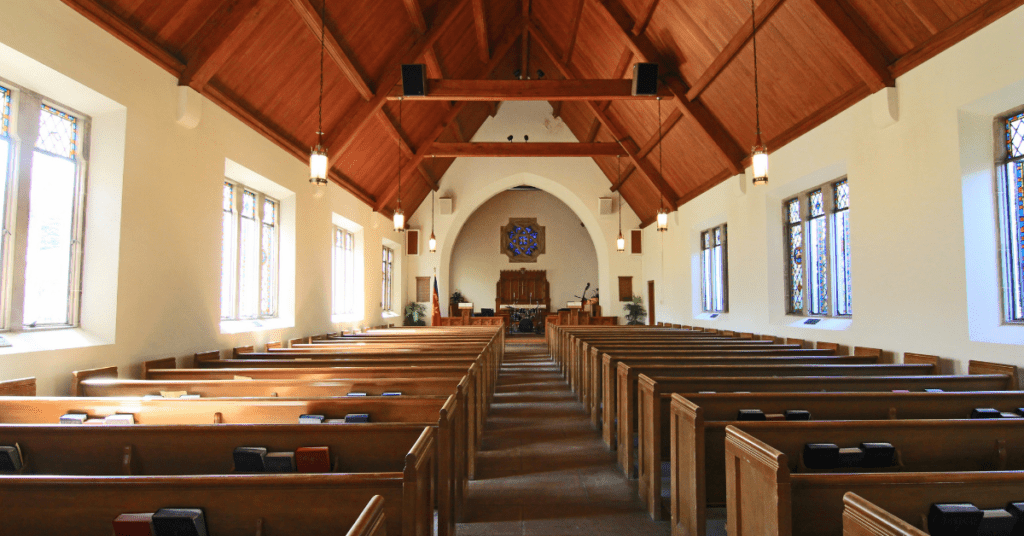“The absence of the disability community from the church is not a matter of invitation; it is a matter of inclusion.” -Lamar Hardwick
You see, there is a lack of presence of those with disabilities in the church because they do not feel as though they are included.
Many church services lack accessibility into the sanctuary (i.e. a place for a wheelchair to sit without blocking the whole aisle), don’t have resources available for someone who may be deaf or hard of hearing, do not have any accommodations for a child with a disability in the Sunday School classrooms, or don’t have a handicap stall that can accommodate a wheelchair or a child who needs assistance using the bathroom.
These may seem like small things to you and I. However, when a family who is affected by disability already goes through a great deal to get out the door on Sunday mornings to come to a worship service, it is an even bigger turn-off to be going to a facility that makes the experience logistically much harder, and maybe even unsafe (like a wheelchair blocking an exit in case of an emergency).
These are all things to consider when we are considering what it is like to be a truly inclusive congregation–meeting the needs of everyone who is a part of the Body.
What is an Inclusion Ministry?
I will begin by explaining what exactly an inclusion ministry is. I believe that too many people overthink what this is. Including those affected by disability in church starts with seeing everyone as a child of God and someone who is worthy to receive the same opportunities to worship and gather in corporate fellowship and worship like everyone else.
An inclusion ministry does not have to be formal. Inclusion ministry within a church is a matter of the heart. Yes, something formal may come out of it, and of course that’s wonderful! However, that is not where the matter of inclusion starts. As I mentioned previously, being able to have a successful inclusion ministry, formal or not, starts with seeing every person in the same way that God sees them-as His creation who has a purpose, which is to glorify Him with their unique set of gifts and talents.
1 Samuel 16:7b says, “For the Lord sees not as man sees: man looks on the outward appearance, but the Lord looks on the heart.” This is the meat of this message. If you are not able to look at someone the way God sees them, then inclusion ministry is going to be difficult for you and/or your church. If you quickly see the ways in which someone is unable to contribute to the church, how accomodating them feels like a burden, how they may “interrupt” the service, then you may need a heart check.

Of course, when someone is affected by a physical disability, there are things that are noticed upon looking at them, but the point is that you should be able to look beyond that and see the beauty in their personality and in the contribution to the body of Christ that they are. That is the reality–they contribute to the body of Christ in their own unique way and that looks different for everyone. That’s totally okay! It’s good. The body would not be valuable if it consisted of 30 feet and no legs. This passage also gives a wonderful view of how we all contribute to the body and is at the heart of inclusion as well:
“The eye cannot say to the hand, “I have no need of you,” nor again the head to the feet, “I have no need of you.” On the contrary, the parts of the body that seem to be weaker are indispensable, and on those parts of the body that we think less honorable we bestow the greater honor, and our unpresentable parts are treated with greater modesty, which our more presentable parts do not require. But God has so composed the body, giving greater honor to the part that lacked it, that there may be no division in the body, but that the members may have the same care for one another. If one member suffers, all suffer together; if one member is honored, all rejoice together.
Now you are the body of Christ and individually members of it. And God has appointed in the church first apostles, second prophets, third teachers, then miracles, then gifts of healing, helping, administrating, and various kinds of tongues. Are all apostles? Are all prophets? Are all teachers? Do all work miracles? Do all possess gifts of healing? Do all speak with tongues? Do all interpret? But earnestly desire the higher gifts.
And I will show you a still more excellent way.” -1 Corinthians 12:21-31 (ESV)
All of this summed up to say-inclusion ministry, formal or not, starts with the position of your heart towards those with differences. I would encourage you to remind yourself of what God says about His children in the Bible and how that can apply to what you’re pursuing within your church as an inclusion ministry.
How Can Inclusion Be Done
I want to lay out several examples, formal and informal, of how inclusion ministry can be done.
First and foremost, as has been discussed, inclusion happens when we see each individual as who God says they are-His child, dearly loved. On that note, inclusion can something simple like noticing someone who is in a wheelchair unable to find a spot in the sanctuary because there are no spaces for them. You could initiate moving some chairs out of an aisle to make room for a wheelchair so they are included with everyone else.

If your church has pews, then you could sit in the front row with them if there is no one else there so that they don’t feel alone or out of place. You could also go to the pastor or leadership team and suggest one or two of the pews being cut in a few feet so that there is room for a wheelchair. This seemingly small thing can make a huge difference for someone who is struggling to find a place to put their wheelchair and then ends up in the back of the sanctuary alone, or worse yet, leaving altogether.
Let’s consider another way you can practice inclusion. Say that there is a family visiting church that has a very young child with Down Syndrome. Maybe they don’t feel comfortable sending their child to the nursery because they are unsure if the nursery workers can handle it, and they are not wanting to ask. You could gently approach the family, say they have a beautiful child, and then let them know that if they would like to send their child to nursery, the workers would be more than willing to learn the proper care from the parents for a week or two and then when everyone feels comfortable with the situation, they can sit in the church service for the whole time. This one small conversation can make a world of difference for a family who needs that spiritual refreshment each week from worshiping with other believers.
As far as something formal being set up for inclusion, there are several options:
As suggested in the example above, there can be a setup for nursery/early childhood classrooms that eases parents who aren’t sure if they can or should drop off their child. It is important that volunteers know to be welcoming and willing to take on children who are visiting or members of the church. They should also feel comfortable–or have a contact on staff/leaderhsip of the children’s program–asking for clarification on certain issues that may be going on or care needs that may be there. In any annual or other training that goes on for childcare workers, there should always be a portion that includes preparation for a child who may have extra needs. Parents should also be a part of the initial process of getting a child acclimated to the classroom. It is common at this age for a neurotypical child to have separation anxiety, and that can be exasperated for a child who has extra needs. The parents are the greatest asset–they know the child best! Allow them to sit in and guide teachers and helpers on how to best support their child. Allow the transition to be gentle.
For elementary and middle school, things for inclusion are much the same. Parents should be involved in the beginning and sharing how to best support their child, and parents should know that they should always be able to be contacted during the service in case something comes up.
At this age, the possibility for a one-on-one buddy may need to be discussed depending on the child’s needs. This may largely depend on the teacher’s comfort level with the child in the classroom, as well as how many other children are in the classroom. If there are 15 children and only one teacher and one helper, a child who has extra needs will likely feel overwhelming. This may be easily resolved by simply just having one more helper in the room, or it may mean that the child who has extra needs will need a one-on-one buddy.
Choosing a one-on-one buddy is important work. The person chosen does not necessarily need to have experience working with children who have special needs, but they will need to have a loving and willing heart to learn and be flexible. They also need to be extremely reliable. It is hard enough for a family affected by disability to get out the door to church on Sunday mornings. Adding in the variable of whether or not the volunteer for their child will show up or not will likely be too much/too stressful. These expectations need to be made clear when you interview the volunteer (yes, an interview–whether in person or on the phone-should be a part of this process).
Again, inclusion in high school involves many of the same processes as above. The big difference here is that you have an opportunity as a ministry leader to involve other students in the intentionality of inclusion. Teaching students at any age that inclusion is important is necessary, of course. However, students who are in high school have an opportunity to lead and take initiative on inclusion and helping a student affected by disability feel included just like everyone else. Make sure that your students who have extra needs are included in all aspects of high school ministry (as well as what the parents would like for their involvement). No one should be intentionally excluded from an activity.
Budgetary Concerns
If you’ve ever gone to leadership at a church with a new ministry idea, one of the first questions you will likely be asked is, “How much is this going to cost?” A reasonable question since most churches don’t have endless financial resources.
It will be beneficial for you if you can consider what the costs may be before you bring a formal idea to leadership. Are you going to need to make modifications to the building? Will extra supplies be needed for classrooms (i.e. headphones for sensory needs)? What will the cost of extra training days for inclusion volunteers be? Of course, this is not an exhaustive list of costs to consider-just some ideas to get your list of potential costs going. Leadership at your church will appreciate your forethought and it also shows that you are serious and committed to seeing this ministry through.

Volunteer Readiness
A big piece of inclusion is volunteer readiness. As mentioned above, a person does not need experience with individuals affected by disability in order to serve as an inclusion volunteer. However, they should have some extra training so that they feel equipped to serve these children/kids/young adults. This can look like adding on a session to your church’s normal childcare worker training days. If your church doesn’t have that, then it could mean meeting with that volunteer/volunteers on a separate occasion and putting together some information and policies for them so they are equipped and prepared. It is also extremely important that volunteers know that you are ready and willing to help with any questions they may have. This means during the service, during the week if they’re serving at a mid-week program, or whenever they have questions that pop up at other times. Your presence and quick response will make all the difference in the world as you serve these families who are affected by disability.
As you can see, an inclusion ministry does not have to be complicated. It can be formal or informal, and it all starts with a conversation with leadership. Thank you for responding to the prompt God has put on your heart to start a disability ministry–many families will be blessed by your heart!

